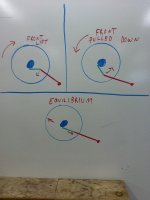The second link was in fact 'idiots' that probably said "hold my beer and watch this".
Hey, I take offense to that statement

Anyway, I have been following this thread, and have been reluctant to post, But for some reason, today I feel compelled to do so:confused2:
I am going to say with 99% certainty, that pulling from a drawbar BELOW the axle, EVEN if it is shorter than the tire radius, WILL preven a backflip.
The 1% is because there are a TON of variables, like momentum, chain breakage, speed, terrain, etc.
BUT, IF you have an immovable object AND an unbreakable chain, AND unlimited traction, and hook to the drawbar, you will NOT flip. Reasons to follow as well as pics.
Sorry for the crude pics hand drawn on the white board in the shop. But the Blue represents the tires, the green is the drawbar, and the red is the chain.
As you can see, in the 1st pic (top left) that the chain is at a pretty stllp angle. ~30 degrees. As you pull, the front WILL raise up in the air, but ONLY to the equillibruim where the chain and the drawbar form a straight line. SEE the BOTTOM pic.
Once equillibrium is reached, the front can NO longer raise. At this point, several things can happen.
1.You will break traction, and the front will come back down
2.The object will begin to move and no longer have enough resistance to hold the front up and the front will come down
3. The chain will break. And depending on wheel speed(if spinning) and momentum, the front will either settle back down, or you could go on over backwards.
As you can see in the second pic (top right) why you will never go beyone the equillibrium point. Because beyond that, it WILL try to pull the front back down, or force the object to move. Because the higher the tractor goes, the drawbar rotates under the axle and forward. And it CANNOT go forward it the object is truly immovable regardless of traction and power.
Remember the shortest distance between two points is a straight line. And by pulling on the chain, that is what the chain-drawbar connection is trying to achieve.
The steeper the chain angle, the more downward force/traction on the rears, and also the higher the front will go to achieve equillibrium. That is why a lot of these videos on youtube the look "scary" really arent, and why you see tractors at the pull slowly bouncing the front up and down. Because as the front lifts, maximum traction and pulling power is attained at equillibrium point, the object will begin to move, the front will settle back down until you can no longer pull the object, and then the front will rear up again and the process is repeated over and over.
This is also why it is NOT advised to pull from the 3PH, even if you lower it all the way. Because it acts like a floating drawbar. There is NOTHING holding it down. So equillibrium wont be reached until the 3PH has ran out of upward travel, and by that time (depending on how short you chain) you could already be vertical:confused2:
And to everyone who disagrees because they have "seen or heard of it happening" when hooking to a drawbar, that is probabally the 1% I mentioned earlier, and probabally operator error. Like jerking and breaking a chain (a lot of momentum) or Being at equilibrium with the fronts up a foot or two in the air and spinning the tires 90 MPH, or popping the clutch. There are no safeguards that can protect aginst stupidity.


